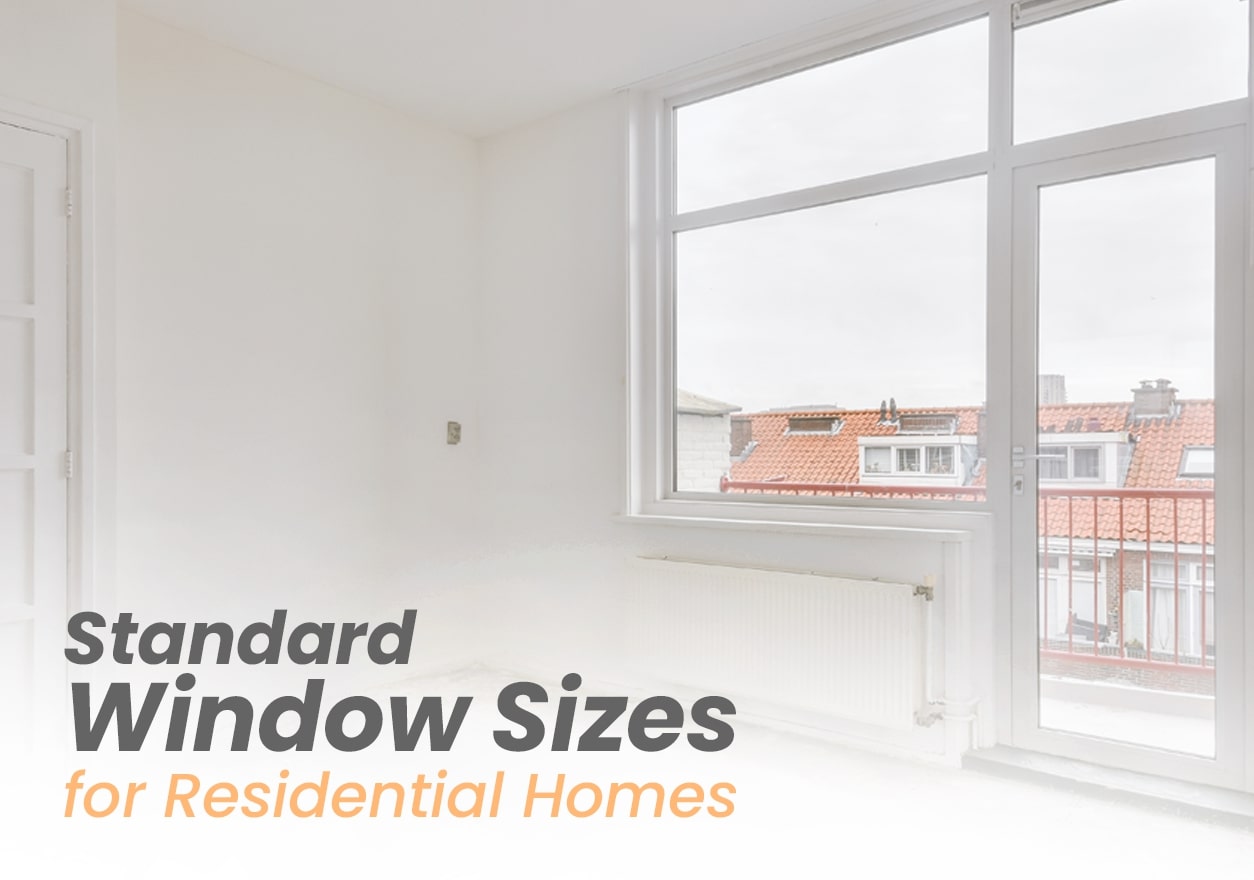
What are the Standard Window Sizes for Residential Homes?
Experience the perfect blend of practicality and elegance with the right window sizes for your home.
Standard window sizes are common sizes used in most homes. It makes installation quick and easy. Using these sizes can save time and money. It also gives homes a neat and stylish look. If building or replacing, knowing these sizes helps you pick the right windows. Residential standard window sizes work for many home styles and needs.
What is meant by Standard Window Sizes?
Standard window sizes are common window measurements that fit most homes and make installation simple.
Why do Homes use Standard Window Sizes?
Using standard window sizes is smart for many reasons:
- Easy to Install: It fits quickly without extra work.
- Cheaper Option: Ready-made windows cost less than custom ones.
- Available Anywhere: You can find them in any home improvement store.
- Follow Rules: It meets most local building codes.
Common Standard Window Sizes for Homes
Here are typical sizes for popular window types:
- Single-Hung Windows:
- Width: 24 to 48 inches
- Height: 36 to 72 inches
- Double-Hung Windows:
- Width: 28 to 48 inches
- Height: 36 to 72 inches
- Sliding Windows:
- Width: 36 to 84 inches
- Height: 24 to 60 inches
- Casement Windows:
- Width: 12 to 36 inches
- Height: 24 to 84 inches
- Picture Windows:
- Width: 24 to 96 inches
- Height: 12 to 96 inches
How do you Pick the Right Standard Window Size?
Choosing the right window size depends on:
- Room Size: Bigger rooms look better with large windows.
- Purpose: Decide if you want more light, air, or just a great view.
- Home Style: Match the window size to the design of your home.
- Energy Savings: Use windows with double glass to save on bills.
Standard window sizes are the most convenient option for homes. It is easy to install, budget-friendly, and widely available. Choosing the right size ensures your home looks great and works efficiently. For most standard window sizes for homes, standard window sizes are the simplest and smartest choice.
What Types of Windows are common in Homes?
Homes often use single-hung, double-hung, sliding, casement, and picture windows in standard sizes.
- Single-Hung Windows
- One part moves up and down.
- Good for bedrooms and smaller rooms.
- Double-Hung Windows
- Both parts can move up or down.
- Great for airflow in living rooms.
- Sliding Windows
- Open by sliding sideways.
- Perfect for kitchens and modern homes.
- Casement Windows
- Open outward like a door.
- Best for bathrooms or tight spaces.
- Picture Windows
- Do not open; fixed in place.
- Ideal for large views and sunlight.
- Awning Windows
- Open from the bottom outward.
- Useful for air during light rain.
- Bay and Bow Windows
- Extend out from the wall.
- Add space and make homes look stylish.
Standard window sizes make these common types affordable, easy to install, and a great choice for homes.
Which Residential Standard Window Sizes are Best for Bedrooms?
Residential standard bedroom windows are usually sized for ventilation, light, and safety, with common dimensions for easy fitting.
- Egress Requirements: Bedroom windows must meet building codes for emergency exits.
- Ventilation Needs: Larger windows allow better airflow, improving comfort.
- Natural Light: Standard window sizes brighten the bedroom while maintaining privacy.
- Energy Efficiency: Double-pane windows in standard sizes help save energy costs.
Why Residential Standard Window Sizes Work for Bedrooms
- Cost-Effective: Ready-made sizes are more affordable than custom designs.
- Easy to Replace: Widely available and simple to fit into existing spaces.
- Flexible Options: Sizes work with different bedroom styles and layouts.
Are Residential Standard Window Sizes Different for Living Rooms and Kitchens?
Yes, residential standard window sizes vary for living rooms and kitchens based on space, function, and natural light needs.
Living rooms and kitchens serve different purposes, so their window sizes differ. Here’s why:
- Living Rooms:
- Need larger windows to allow more natural light.
- Common sizes: 48 to 72 inches wide and 48 to 60 inches tall.
- Often feature pictures or bay windows for a better view and aesthetics.
- Kitchens:
- Smaller windows fit better above sinks or counters.
- Common sizes: 24 to 48 inches wide and 24 to 36 inches tall.
- Casement or sliding windows are popular for ventilation.
Key Factors that affect Window Size Differences
- Room Function: Living rooms focus on light and views, while kitchens prioritize ventilation and practicality.
- Space Availability: Kitchens often have cabinets and counters limiting window size.
- Aesthetic Needs: Larger windows in living rooms create a more open and inviting feel.
Residential standard window sizes are different for living rooms and kitchens to match their unique needs. Larger windows suit living rooms, while smaller, functional ones work best in kitchens. Picking the right size improves both function and style.
How Do You Choose the Right Window Size for Small Spaces?
Choose compact windows that maximize light and fit well with the room’s layout.
- Use taller windows to create an illusion of height.
- Opt for sliding or casement windows for better space use.
- Pick energy-efficient glass to enhance functionality.
- Avoid oversized windows that overwhelm the room.
Can Standard Window Sizes Fit Older Homes?
Yes, standard window sizes can fit older homes with some adjustments.
In older homes, window openings may not match modern standard sizes exactly. Minor changes, like resizing the frame or using filler materials, can make standard window sizes work effectively. This saves costs compared to fully custom windows.
How Much Do Standard Windows Cost?
Standard windows cost between $100 and $1,000, depending on type, size, and material.
|
Window Type |
Price Range (Per Window) |
| Single-Hung Windows | $100–$400 |
| Double-Hung Windows | $150–$600 |
| Sliding Windows | $200–$800 |
| Casement Windows | $300–$1,000 |
Material Impact:
- Vinyl: Most affordable
- Wood: Moderate cost
- Aluminum: Higher-end option
FAQs
What Materials are used for a Window Frame?
Window frames are commonly made of wood, vinyl, aluminum, or fiberglass for durability and style.
Can I order custom-sized windows for my home?
Yes, custom-sized windows can be made to fit any unique space or design requirement.
What are standard sliding window sizes?
Sliding window sizes typically range from 36 to 84 inches wide and 24 to 60 inches tall.
What are common picture window sizes?
Picture windows usually measure between 24 to 96 inches wide and 12 to 96 inches tall.
How tall can a window be in feet?
Standard windows can be up to 8 feet tall, depending on the type and design.
What are the typical awning window sizes?
Awning window sizes usually range from 24 to 48 inches wide and 20 to 36 inches tall.
What are standard double Hung window sizes?
Double-hung windows commonly measure 28 to 48 inches wide and 36 to 72 inches tall.

Take the Next Step!
RELI Solutions Inc. is your trusted window manufacturer for all your home improvement needs. They specialize in creating custom window sizes to fit your unique style and space. If you’re looking for standard window dimensions or need replacement windows, their skilled team is here to help.
With a focus on quality and care, you can rely on their expertise to deliver the best results every time. Your satisfaction is always their top priority, ensuring your home projects are stress-free and successful.
Services Offered by RELI Solutions
Here’s a list of their key services:
| Service | Description |
| Window Installation | Install and replace windows to improve looks and save energy. |
| Door Installation | Install and replace doors, including entry and patio doors. |
| Home Renovations | Renovate homes with quality work and great designs. |
| New Construction Windows | Install windows and doors for new homes with custom designs. |
A mobile app is a program made for phones and tablets. It helps people do tasks, get services, or have fun. You can download apps from places like the App Store or Google Play. Apps are easy to use and work smoothly on your device.
They are used for many things like chatting, playing games, shopping, or getting work done. Many businesses use apps to stay connected with their customers and make services easier to use anytime, anywhere.
